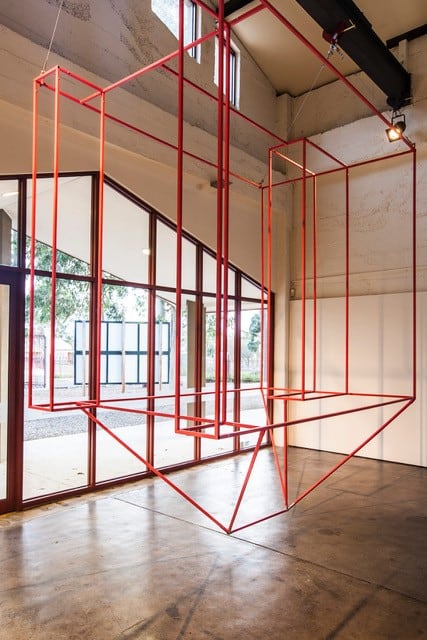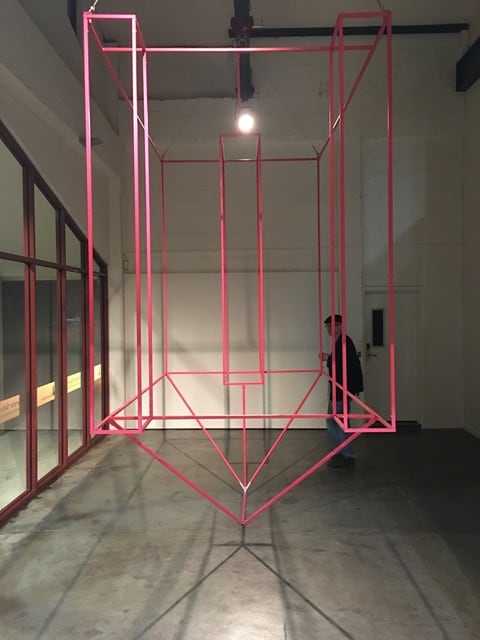

The discourse that defines and supports the discipline of architectural studies has historically focused its attention on the study and veneration of great men and great monuments, a focus that has erased the contributions of many women in the field.1 - Elizabeth Joy Birmingham, 2000
Sculptor Tracey Lamb pushes back against the erasure of women in the field of design and architecture, carving out space for forgotten and relegated Western female voices through an installation-based practice. Lamb’s most recent investigation in Incinerator Gallery’s Atrium Space, The eyes that saw her were closed (2018), brings the work of pioneering female architect Marion Mahoney Griffin (1871-1961) to the fore.
American-born Mahoney Griffin was one of the world’s first licensed female architects. The legacy of her prolific output across America and Australia is still influential today, as evident through her early design vision for Canberra. Paralleling wider historical recordings of women in design, Mahoney Griffin’s substantial contribution to architectural practice was often not recorded, or it was demeaned. Her work was subsumed by her male colleagues, notably her employer Frank Lloyd Wright and her husband, Walter Burley Griffin.
As was the case for most of the Griffins’ architectural undertakings, Mahoney Griffin worked as co-designer with her husband on Incinerator Gallery (previously known as Walter Burley Griffin Incinerator), making it a fitting home for The eyes that saw her were closed. Using elements from Mahoney Griffin’s architectural line drawings as a guide, Lamb has produced a large welded steel structure, measuring 3.6m x 3.05m x 1.8m, painted in a dusty deep pink tone of acrylic paint. The shade chosen references a Tasmanian landscape painting by Mahoney Griffin called Eucalyptus Urnigera Tasmania, Scarlet Bark, Sunset (1919) – a detail that acknowledges Lamb’s commitment to representing Mahoney Griffin with well-rounded and thoughtful consideration. The sculpture is suspended from taught steel wires that meet two heavy-duty red clamps, attached to the metal beam that supports the atrium ceiling. It appears to be an upside down house of sorts, with thin vertical lines that come to an inverted roof-like point, roughly 15cm from the ground. The visual ease of the clamps does not belie the effort behind suspension. The metal cables are straining from the weight. The sculpture is slick and precise—a testament to Lamb’s technical skill and methodical efforts as a maker—yet we are still aware of the emotional and physical labour behind its creation, and the accompanying duress that surrounds the erasure of female voices in the history of art, design and architecture.
Scholar Elizabeth Joy Birmingham writes:
‘the substantiality of the architectural construct is created not so much of the builders’ materials of steel girders or reinforced concrete piers but of gossamer layers of description [...] The architecture is the discourse; the discourse is the architecture’.^2
With each window frame set and steel beam hoisted under the misnomer of Walter Burley Griffin Incinerator— a name that implies Burley Griffin was the sole architect of the project— Mahoney Griffin’s presence within the design-process was erased. Through the language of sculptural construction and thoughtful feminist interrogation, Lamb has created space for Mahoney Griffin to finally receive her dues. As I walk around the sculpture, I can see Lamb tightening the silver bolts by hand and Mahoney Griffin methodically drawing her designs. The vertical lines catch you from different angles, at-once meeting and withdrawing from the linear maroon window frames of the gallery space. Circling the sculpture, my eyes compress and conflate picture planes, closing and opening the box-like form that Lamb has created. I have entered a dialogue between Lamb and Mahoney Griffin. To be within such a conversation, where both voices have such strong conviction, is a true privilege.
Josephine Mead is a visual artist and writer with an interest in personal notions of support. She has exhibited widely in a range of venues including Kings Artist-Run, Seventh, Blue Oyster Space, Testing Grounds and the Monash and RMIT faculty galleries. She is currently undertaking the MacFarlane Fund Residency in Kyneton.
